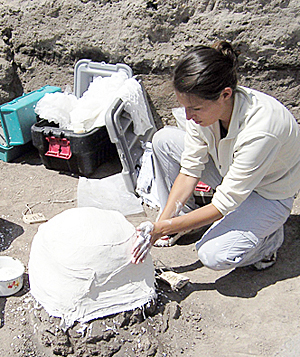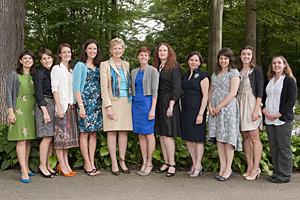

ADVERTISEMENT
- Rozovsky wins prestigious NSF Early Career Award
- UD students meet alumni, experience 'closing bell' at NYSE
- Newark Police seek assistance in identifying suspects in robbery
- Rivlin says bipartisan budget action, stronger budget rules key to reversing debt
- Stink bugs shouldn't pose problem until late summer
- Gao to honor Placido Domingo in Washington performance
- Adopt-A-Highway project keeps Lewes road clean
- WVUD's Radiothon fundraiser runs April 1-10
- W.D. Snodgrass Symposium to honor Pulitzer winner
- New guide helps cancer patients manage symptoms
- UD in the News, March 25, 2011
- For the Record, March 25, 2011
- Public opinion expert discusses world views of U.S. in Global Agenda series
- Congressional delegation, dean laud Center for Community Research and Service program
- Center for Political Communication sets symposium on politics, entertainment
- Students work to raise funds, awareness of domestic violence
- Equestrian team wins regional championship in Western riding
- Markell, Harker stress importance of agriculture to Delaware's economy
- Carol A. Ammon MBA Case Competition winners announced
- Prof presents blood-clotting studies at Gordon Research Conference
- Sexual Assault Awareness Month events, programs announced
- Stay connected with Sea Grant, CEOE e-newsletter
- A message to UD regarding the tragedy in Japan
- More News >>
- March 31-May 14: REP stages Neil Simon's 'The Good Doctor'
- April 2: Newark plans annual 'wine and dine'
- April 5: Expert perspective on U.S. health care
- April 5: Comedian Ace Guillen to visit Scrounge
- April 6, May 4: School of Nursing sponsors research lecture series
- April 6-May 4: Confucius Institute presents Chinese Film Series on Wednesdays
- April 6: IPCC's Pachauri to discuss sustainable development in DENIN Dialogue Series
- April 7: 'WVUDstock' radiothon concert announced
- April 8: English Language Institute presents 'Arts in Translation'
- April 9: Green and Healthy Living Expo planned at The Bob
- April 9: Center for Political Communication to host Onion editor
- April 10: Alumni Easter Egg-stravaganza planned
- April 11: CDS session to focus on visual assistive technologies
- April 12: T.J. Stiles to speak at UDLA annual dinner
- April 15, 16: Annual UD push lawnmower tune-up scheduled
- April 15, 16: Master Players series presents iMusic 4, China Magpie
- April 15, 16: Delaware Symphony, UD chorus to perform Mahler work
- April 18: Former NFL Coach Bill Cowher featured in UD Speaks
- April 21-24: Sesame Street Live brings Elmo and friends to The Bob
- April 30: Save the date for Ag Day 2011 at UD
- April 30: Symposium to consider 'Frontiers at the Chemistry-Biology Interface'
- April 30-May 1: Relay for Life set at Delaware Field House
- May 4: Delaware Membrane Protein Symposium announced
- May 5: Northwestern University's Leon Keer to deliver Kerr lecture
- May 7: Women's volleyball team to host second annual Spring Fling
- Through May 3: SPPA announces speakers for 10th annual lecture series
- Through May 4: Global Agenda sees U.S. through others' eyes; World Bank president to speak
- Through May 4: 'Research on Race, Ethnicity, Culture' topic of series
- Through May 9: Black American Studies announces lecture series
- Through May 11: 'Challenges in Jewish Culture' lecture series announced
- Through May 11: Area Studies research featured in speaker series
- Through June 5: 'Andy Warhol: Behind the Camera' on view in Old College Gallery
- Through July 15: 'Bodyscapes' on view at Mechanical Hall Gallery
- More What's Happening >>
- UD calendar >>
- Middle States evaluation team on campus April 5
- Phipps named HR Liaison of the Quarter
- Senior wins iPad for participating in assessment study
- April 19: Procurement Services schedules information sessions
- UD Bookstore announces spring break hours
- HealthyU Wellness Program encourages employees to 'Step into Spring'
- April 8-29: Faculty roundtable series considers student engagement
- GRE is changing; learn more at April 15 info session
- April 30: UD Evening with Blue Rocks set for employees
- Morris Library to be open 24/7 during final exams
- More Campus FYI >>
11:23 a.m., Sept. 2, 2010----Joan Miró, Vincent Van Gogh and Pablo Picasso would be cheering them on.
Graduate students in art conservation at the University of Delaware have painstakingly cared for works of art by many such renowned masters recently.
They also have treated and preserved portions of Christo and Jeanne-Claude's 24.5-mile-long temporary artwork Running Fence, a 2,000-year-old Roman sarcophagus, an entire room from Damascus, Syria, installed at the Metropolitan Museum of Art, a flag that waved as the New York regiment headed to the Civil War battlefield in 1861, and much more.
On Aug. 24 at Winterthur, the nine third-year students in the Winterthur/University of Delaware Program in Art Conservation (WUDPAC) detailed their past two years of experiences, including summer work projects and an 11-month advanced internship, in heartfelt oral presentations. The students showcased the object assessments and treatments they undertook using tools ranging from paintbrushes to X-ray fluorescence spectroscopy, and the lessons they learned under the guidance of professional conservators.
Jessica Arista's internships took her on a journey from ancient Crete to the Mayan culture with an important stop in Baltimore in between.
At Kaman-Kalehöyük, a Bronze Age archaeological site in Turkey, Arista learned to care for excavated finds that had been buried for thousands of years. Then, at the Walters Art Museum in Baltimore, which has the third oldest art conservation laboratory in the United States, she used her skills to treat a Mycenaean ceramic jug decorated with the painting of a nautilus with its tentacles out. The jug had been contaminated with potentially damaging salts. Arista carefully removed the shellac and plaster fills from past repairs, soaked the jug to remove the salts, and then filled in previous losses in the jug's decoration using Japanese paper.
Also while at the Walters, Arista cleaned and treated a garland sarcophagus (so-named for the motif decorating its sides), made of marble and discovered near Rome in 1885, and prepared the 600-pound coffin for travel to the Cleveland Museum of Art for the upcoming “Treasures of Heaven” exhibition. The article Arista wrote about the project for the museum's magazine piqued the interest of a reporter at the Baltimore Sun. In the subsequent newspaper article, Arista's technique was compared to that of the pointillist painter Georges Seurat.
Not bad for a blossoming art conservator.
Arista said her internships reinforced why she went into art conservation.
“You are always learning -- with each new object, new people and each new place you go,” she said.
According to Debra Hess Norris, Henry Francis du Pont Chair of Fine Arts, chair of the Department of Art Conservation and WUDPAC director, all of the third-year students successfully completed the oral presentations and portfolios required for the master of science degree in art conservation. They will now go on to professional positions and fellowships at the National Gallery of Art, the Metropolitan Museum of Art, Historic New England, the Museums of New Mexico, the Smithsonian Institution, a private practice in New York City, the Walters Art Museum and Winterthur.
Founded in 1974, WUDPAC is one of only four graduate programs in the United States that educates and trains art conservation professionals. For more information, visit the website.
Article by Tracey Bryant


